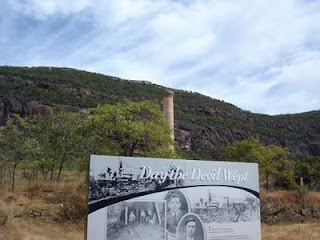
Sunset over Mt Mulligan
Mount Mulligan was a coal mining town that ceased to exist in 1958. The town is/was based at the foot of Mt Mulligan, named after James Venture Mulligan who sighted the mountain in 1874. Gold was discovered on the Hodgkinson River during Mulligan's 5th expedition in 1876. The discovery of gold brought a rush of prospectors to the area with camps and small settlements along the Hodgkinson river. Ironically it was coal that was being sought after at Mt Mulligan

Ventilation shaft
Coal was discovered in the mountain in 1907. Commercial mining of coal commenced in approx. 1914. Coal was never very profitable as the method of mining was very expensive and labour intensive. The poor quality of the coal and transport problems ensured a slow decline of the township.

The town lasted for only fifty years but in that time it had experienced one of Queensland's worst mining disasters. A historical marker (below) erected in recent years tells about this disaster. "On Monday 19th September 1921 at 9:25 there was a loud explosion in the mine which killed 75 men. The explosion was heard 60 kilometres away at Mount Molloy".

The rusting remains of the town can still be seen and after a recent Mount Mulligan reunion the streets and important sites have been marked with signs. The only remaining intact building is the hospital which is now part of Mt Mulligan Station.


The Mt Mulligan cemetery, hastily built and consecrated after the disaster. More information here.

Mount Mulligan Disaster
After the Mount Mulligan disaster school children from around Queensland wrote to children at Mount Mulligan. Herbert Smithson from Mount Mulligan State school, whose father William Robert Smithson was killed in the disaster, replied to a child from Sandford, Mackay. He wrote:
Dear Schoolmates,
We thank you for your kindness & for yours letters of sympathy. Some day I hope to have the pleasure of meeting you. The accident happened at 25 past nine on Monday the 19 of September and they got all the men out some on Monday Tuesday Wednesday Thursday and Friday. The explosion started up at the fan and then in the tunnel. the blacksmith shop got blown to bits. The man who was in the shop got blown 200 yds away from the tunnel and after the explosion they went down the [mine] and worked all night and day looking for the men Everyday the people used to have breakfast dinner and tea up at the mine.
(Quoted in Bell, appendix B)
Herbert would go on to become a coal miner. In June 1942, while working at Collinsville State Mine, he was killed in an accident.
P. Bell, ‘If Anything, Too Safe’ (Townsville, Qld, 1996)

For a more detailed history of Mt Mulligan Click Here.
P. Bell, ‘If Anything, Too Safe’ (Townsville, Qld, 1996)

For a more detailed history of Mt Mulligan Click Here.
No comments:
Post a Comment